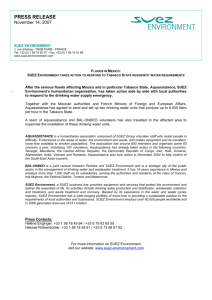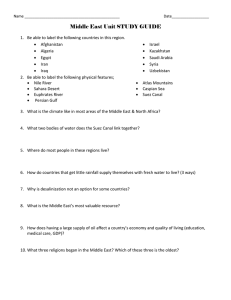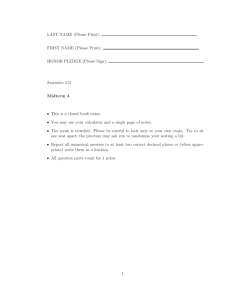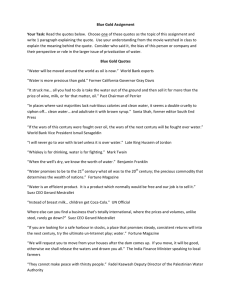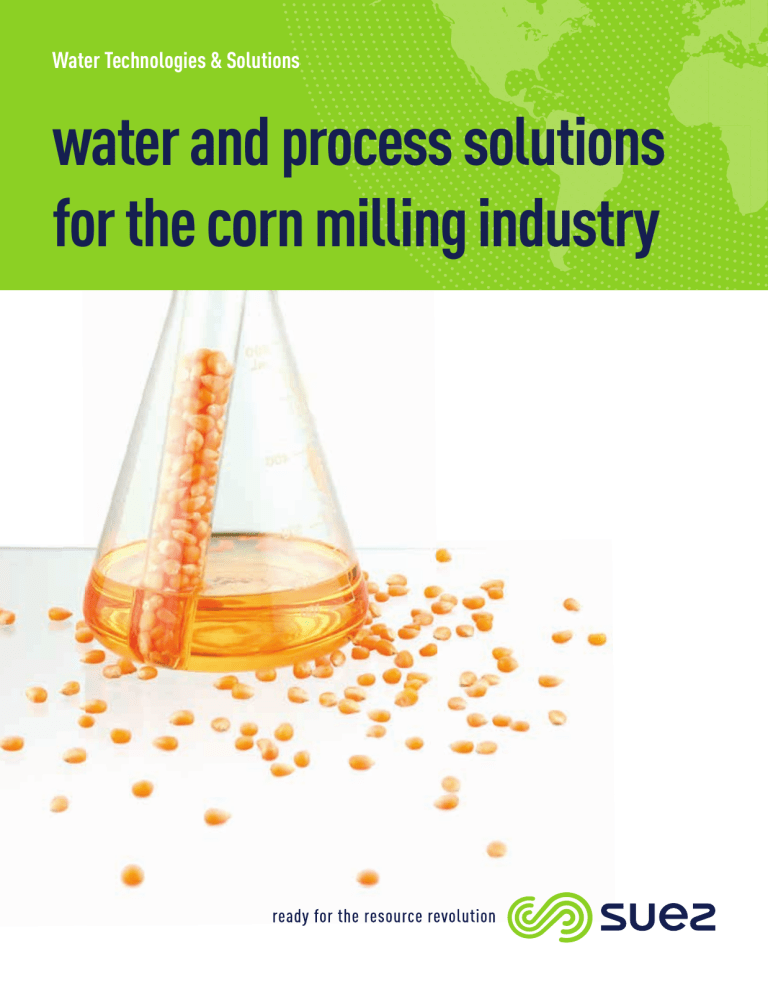
Water Technologies & Solutions Water Technologies & Solutions water and process solutions for the corn milling industry corn milling industry: a sector in expansion the increase in ethanol demand is a global trend. A heightened demand for renewable fuels has stimulated investments in several global regions, including Brazil, United States, Colombia, South Africa and Southeast Asia. With this continued expansion, corn milling plants must be vigilant about selecting efficient equipment and engaging in proper maintenance to increase product life cycles and reduce operating costs in order to meet projected growth. Increasing productivity and ensuring product quality are some of the major challenges corn milling plants face. Understanding the unique needs of the corn sector, SUEZ develops and offers high-quality products and services that support a plant from the beginning to end of the corn milling process. For more than a century, SUEZ has provided sustainable solutions to help customers around the globe address some of the world’s most pressing challenges. Today, SUEZ Water Technologies & Solutions continues that commitment. We are a forward-thinking and thoughtful leader in developing the water, water recycling, wastewater treatment and process solutions our customers need to operate more efficiently and profitably, while minimizing their environmental footprint. Our goal is to help industries thrive and communities prosper. SUEZ process solutions 1. 2. 3. 4. 5. 6. 2 process solutions ............................................................................................................................................................................................................... pages 6 and 7 cooling water services ..................................................................................................................................................................................................... pages 8 and 9 boiler treatment ............................................................................................................................................................................................................................... page 11 water and wastewater treatment ........................................................................................................................................................................................... page 10 membrane chemicals ................................................................................................................................................................................................. pages 12 and 13 TrueSense* monitoring and control ................................................................................................................................................................... pages 14 and 15 3 SUEZ solutions for the corn milling industry process solutions 1 cooling water services 2 boiler treatment 3 corn water and wastewater treatment 4 silos membrane chemicals 5 1 steeping tank 6 monitoring solutions 6 steep water evaporator dryer fiber washing (DSM screen) dryer starch/gluten separation 1 fiber mill degerminator mill 1 1 dryer 6 centrifuge starch washing cyclone screwpress oil extraction 1 starch conversion and refining 1 germ separation hydrocyclone crystallizer 1 germ washing screen 2 scrubber water treatment plant 4 filter dryer 1 cenrtifugation 1 bagging 5 reverse osmosis 3 fermenters sugar storage ethanol distillation 6 cooling tower 2 6 1 1 4 6 wastewater plant power house 4 5 deposit control ethanol corrosion and pH adjustment programs The cost of a food and beverage thermal evaporative process can be minimized by maintaining optimum efficiency of the evaporators and reducing the amount of downtime necessary for cleaning. SUEZ markets a range of chemical additives in its FoodPro* product line, which is designed to improve evaporator efficiency, and has developed programs for reducing poor performance of traditional boil out chemicals and the costs associated with high pressure jetting (Hydroblasting). With the goal of extending the time between boil outs, SUEZ uses unique FDA-approved programs to successfully help wet corn mills reduce the deposition of protein and calcium oxalate type deposits. This translates to increased run times and improved equipment and energy efficiency, and reductions in boil out frequency and energy costs. Ethanol produced for gasoline blends generally has low pH. Because of the water contents and acidity, ethanol can cause corrosion of piping, storage tanks and other transportation equipment. Further, a pH specification (6.5-8.0) is required for ethanol blended with gasoline. Helping plants overcome pH challenges, SUEZ offers two product lines for this application: Endcor* FE for corrosion protection without pH adjustment and Endcor GCC for pH adjustment and corrosion protection, both of which protect transfer and storage equipment. offline cleaners Accumulation of deposits generally occurs in isolated pieces of equipment, such as columns, evaporators and fermenters. Plants have extensive systems for attempting to remove deposits and generally rely on heated caustic solutions as the solvent, which effectively remove protein type deposits. SUEZ’s FoodPro OLC product line was developed as a cleaning technology to remove calcium-type deposition and enhance cleaning efficiency. The benefits range from bacterial hideout removal to increases in production rates and time between cleanings, as well as reduced downtimes. antifoamers SUEZ’s FoodPro FAF products carry FDA approvals and/or kosher approvals, and are designed to control foam in the evaporator during processing to maintain condensate purity. Further, FoodPro FAF products can be added to cleaning solutions and used on liquor evaporators, starch transfer tanks, process filtrate tanks, gluten-starch separation tanks, steeping tanks and fermentation tanks. Silicon or surfactant based, these solutions can help increase product recovery, reduce pump failure, decrease shutdowns and enhance employee safety. dewatering aids As starch, gluten and fibers need to be dried before they can be sold for further use; water is first extracted mechanically and then thermal energy is applied to reduce residual moisture. Chemical dewatering aids can be used to improve the efficiency of the mechanical dewatering step, resulting in solids with reduced moisture entering the thermal driers—ultimately reducing energy consumption. SUEZ’s experienced team works with our customers to screen and evaluate potential programs that will deliver the most benefits possible, including energy savings from the reduction in moisture percentage, increased production and improved efficiency of dewatering equipment. starch preservatives Although the moisture content is low after the starch drying process is complete, microbial activity is still possible and can lead to a reduction in quality of the finished starch. Microbial activity must be avoided in starch used for food process purposes in order to inhibit contamination, and starch used for the paper industry, which needs to keep its specified white color, should be prevented from graying. With these needs top of mind, SUEZ’s unique food grade biocidal formulation can be added to finished starch products in order to extend storage time and prevent quality issues caused by microorganisms. SUEZ’s Biomate* SAN prevents bacteria, fungi and mold from growing in processed starch. SUEZ’s global team can also provide service, technical support, lab testing, toxicity studies and microbiological trials for appropriate applications, helping our customers achieve increased shelf life, reduced starch biodegradation and eliminated microbial growth. by-product recovery Waste from corn milling processes is sent to a waste treatment plant for biological oxygen demand (BOD) reduction using an aeration basin, clarifier, centrifuge or belt press. SUEZ offers polymers, especially formulated for solids recovery systems that can enhance by-product recovery and turn waste treatment into an income producing operation. These polymers can benefit the plant by effectively settling suspended solids, helping the plant meet BOD effluent discharge limits, reducing disposal and handling fees, and reducing the loss of valuable by-product. SUEZ designs water treatment programs that fit the unique needs and increase the productivity of our customers’ corn milling process and non-process water systems. gluten recovery aid Gluten separation and dewatering are key steps in the wet corn milling process. Generally accomplished through screens followed by centrifuges, the protein content of the separated gluten depends on the separation process and fiber content. SUEZ offers a specialty additive to enhance the recovery operation and improve the high fructose corn syrup filtration and enzyme process. This benefits plants by increasing the yield per bushel, assisting with cost savings and enabling higher throughput. process solutions 6 7 cooling water in corn milling plants corrosion In the wet corn milling process, both cooling towers and heat exchangers require protection from microbiological proliferation, deposition, scaling and corrosion. SUEZ provides a range of applications and technologies to address these forces and keep operations running smoothly. Corrosion most often occurs in both the process heat exchangers and system transfer piping. It is the result of an electrochemical reaction that is accelerated in the presence of higher temperatures, low flow or stagnant water conditions and in cases where the cooling water possesses a high concentration of dissolved solids. Causing heat exchangers to leak and rust to form, corrosion shows up as thinning of the tubes or pitting of the base metal. Failure of a critical heat exchanger can mean unscheduled downtime, loss of productivity and increased operational costs. The objective of an effective corrosion control program is to reduce metal corrosion to an acceptable level. Success depends on effective mechanical design, acceptable exchanger metallurgies, and selection and application of an ffective chemical treatment program, based on existing system operational and water conditions. N IO OS UC RR OD CO PR IT OS ION EP OS RR RD DE UN CO WORKING THE TRIANGLE deposit control • Water-Formed Mineral Scales • Water-Borne, e.g. Silts TS UC OD PR ES LIC SIT BO TH TA OW GR • Mild Steel • Copper/Copper Alloys ME Cooling towers are prone to microbiological contamination from the high airborne contaminant levels drawn in by induction fans. Process-related contamination can also occur, which then allows for rapid bacterial growth and associated fouling in the cooling tower’s nutrient-rich environment. When bacteria growth is not controlled, biofilms interfere with equipment performance. Biofouling reduces, or in some cases blocks, water flow, reducing heat transfer and increasing microbiologically induced corrosion (MIC) rates. Some biofilm organisms attack wood, which weakens structural components of wooden cooling towers. Dirty cooling systems also increase the risk of contracting airborne disease from inhalation of microorganisms that are present in cooling tower drift. TS microbiological: bacteria counts • Deposition/ Fouling • Pathogens; Legionella PARTICLE ENTRAPMENT GROWTH SITES The gradual accumulation of deposits in cooling water systems directly affects production. Process heat exchangers are usually the prime sites for deposition since most scaling species have retrograde solubility characteristics. Simply put, scale forms at the hottest locations in the system—the heat exchange surfaces—including the shell/tube and plate/frame variety. Deposition problems can lead to reduced tower efficiency and decreased heat transfer rates, and can reduce the carrying capacity of pipelines. If unchecked, deposition can result in production loss, excessive energy usage, shortened equipment life and increased costs due to frequent cleaning or added pumping requirements. GenGard* technology: for open recirculating cooling systems GenGard is an advanced and cost-effective water treatment technology for the control of corrosion and deposition in open recirculating cooling systems. GenGard reduces production issues and helps costly capital equipment serve its intended useful life. GenGard programs can be applied across a pH spectrum from neutral to alkaline and improves results even under stressful conditions. The patented GenGard technology includes a new Stress Tolerant Polymer (STP), Alkaline Enhanced Chemistry (AEC) and Halogen Resistant Azole (HRA) in combination with phosphate based steel corrosion inhibitors. cooling water services 8 9 wastewater treatment benefits boiler solutions By separating liquids from solids, more insoluble matter can be removed. Anaerobic and aerobic biological systems are able to provide high removal rates for soluble contaminants, increased gas production for steam or electricity and low levels of scaling. In order to provide the heat and power necessary to maintain efficiency and production, deposits and corrosions in boiler systems need to be avoided. U.S. Food and Drug Administration (FDA) standards related to regulated chemical treatments and utility plant operations to prohibit cross contamination from occurring in the steam system also need to be adhered to. SUEZ’s goal is to help our customers maintain plant reliability at low cost while producing high-quality products—be it starches or corn syrups, citric acid or ethanol. biological control Proper biological control is critical to the prevention of waterborne disease and proper operation of equipment, such as cooling towers, heat exchangers, water scrubbing systems and reverses osmosis units. Encouraging microbial growth in wastewater treatment systems may sometimes be appropriate, however, to help ensure the health of beneficial microorganisms that remove specific types of organic matter. As such, SUEZ offers products and treatments to either reduce or augment microorganism growth in water systems. clarification Using exclusive blends of custom-designed polymer formulations, SUEZ’s treatment programs can remove organic color, calcium and magnesium hardness, iron and suspended solids from influent water. These polymers help reduce the need for pH adjustment, decrease load on dematerializers, increase filter throughput and reduce sludge volume. SUEZ also offers technologically advanced and comprehensive resources for wastewater treatment, making effluent waters acceptable for reuse or discharge. metals removal The removal of heavy metals from waste streams is a critical component of industrial wastewater treatment, as these metals do not naturally degrade and can be toxic to aquatic life, even at low concentrations. SUEZ makes it possible for industrial facility operators to reduce heavy metals—including soluble and/or particulate heavy metals, such as lead, copper, chromium, iron and manganese—from waste streams to help ensure regulatory compliance. odor control Whether you process water for public consumption, treat wastewater or run industrial processes in which water purity is essential, control of objectionable odors is a challenge. SUEZ provides a range of advanced products and treatment options for cost-effective odor control in water processing and wastewater treatment. water and wastewater treatment Collection System Lift Station Rotary Screen SOLIDS BioPlus and ScaleTrol 10 KlarAid, Novus, and Polyfloc Solids to Anaerobic Digestion or Animal Feed Dewatering Getting the maximum heat transfer from fuel to steam in boilers is essential to maintaining safe, cost-effective, long-term boiler reliability and low-cost corn milling product operations. A scaled boiler burns more fuel less efficiently than a clean one and is more subject to tube failure, which leads to lower production. The use of high-quality feedwater coupled with optimized chemical treatment—as found in SUEZ’s OptiSperse* AP, OptiSperse CL or OptiSperse PO Series products—helps maintain boiler cleanliness. boiler corrosion control Boiler corrosion can occur in several areas throughout the system. In the preboiler circuit, oxygen pitting can destroy feedwater piping and require a system shutdown while the affected piping is replaced. In the condensate system, boiler feedwater alkalinity or oxygen that has entered the system at some point and process contaminants from evaporator leaks in the corn milling production can cause corrosion. These corrosion mechanisms can cause the loss of piping and transfer of corrosion products into the feedwater, impacting boiler cleanliness and reliability. Proper treatment to minimize preboiler system corrosion requires optimizing mechanical deaeration, followed by using the most appropriate oxygen scavenger—such as CorTrol* IS or CorTrol OS Products. steam purity High-purity steam is essential to keep rotating equipment that uses steam as the source of power generation operating safely and efficiently. Solids in the steam that are a result of carryover will slow down this equipment. These solids will also lead to unsafe operation of the steam plant due to water hammer and hot, high alkaline water entering the steam headers or steam end users. To ensure boilers are operating under the best possible mechanical and chemical conditions, steam purity needs to be maintained at the highest level. boiler treatment KlarAid*, Novus*, and Polyfloc* BioPlus* and ScaleTrol* BioPlus and FoamTrol KlarAid, Novus, and Polyfloc FoamTrol* Liquid to Primary Liquid/Solids Separation DAF or Primary Clarifier High Rate Liquid Anaerobic Digester Liquid to Aerobic Biological Treatment Clarifier/DAF Liquids/Solids Separation Discharge SOLIDS boiler deposit control SOLIDS Liquid Filtrate/Centrate KlarAid, Novus, and Polyfloc Dewatering Belt Press, Centrifuge, Pressure Filter BioPlus and ScaleTrol Landfill or Anaerobic Solids Digester 11 MemChem* chemical solutions are designed to reduce operating costs and decrease energy and water demand while simultaneously improving our customers’ environmental safety. MemChem solutions include a variety of products, including dechlorination, antiscalants, bio control, cleaners and filtration aids that are formulated to enhance the performance of pure water equipment such as cartridge filters, multimedia filters (MMF), carbon, microfiltration, ultrafiltration, nanofiltration and reverse osmosis (RO). Making it possible for your team to focus on core activities, SUEZ provides on- and off-site services to identify and implement a MemChem service program customized to meet your needs. on-site services: • Testing of water chemistry, pH, conductivity, free chlorine, turbidity and SDI • MB tests, microbiological count, BioScan* • System audits, pretreatment and RO systems, system optimization • CIP operation training, membrane storage and system trouble shooting and diagnostics • Optimization of chemical dosages CIP Tank chlorine NSF* Acids pH Adjustment Biomate MBC Biocides Kleen MCT Cleaners CARTRIDGE FILTER SUEZ products Hypersperse Antiscalants • Membrane restoration services MEMBRANE SYSTEM Chlorine Destruction Solisep MPT Coagulants • Membrane autopsy to identify causes for membrane performance degradation • Complete water analysis Continuous/ Intermittent MEDIA FILTRATION off-site services: MemChem solutions: Biocide Deactivation DCL (Bisulfite) • Solisep* MPT Filtration Aid removes particulates that foul membranes, reduces CIP cleaning frequency and operation cost, extends filters and membrane life •M PH* NSF pH Adjustment maintains desired pH, reduces scaling potential, reduces iron and aluminum fouling •D CL* Dechlorination removes chlorine from water and protects membrane from damage •B io Control* and Biomate* MBC maintains clean pretreatment and RO system, maintains optimum membrane rejection percentage, reduces chemical usage and CIP cleaning frequency • Hypersperse* MDC and MSI Antiscalant optimizes RO operation at maximum recovery and extends membrane life, reducing capital cost and chemical costs by reducing CIP cleaning usage • Kleen* MCT Cleaner restores membrane performance, lengthens membrane life and helps reduce membrane replacements productivity tools: • Argo Analyzer* Software predicts critical fouling potential, offers guidance in selecting the best antiscalant, recommends dosages for best RO operating conditions and percent RO recovery and supports operational cost savings • WinFlows* engineering design simulates RO system’s optimum configuration and operation and provides predictions of permeate quality throughout membrane lifespan • RO Normalization Data Sheet engineering tool tracks and monitors RO performance by tracking key operational parameters, helps users troubleshoot and maintain RO and provides guidance in selecting membrane chemicals to provide optimum performance membrane chemicals 12 13 TrueSense monitoring and control SUEZ proudly provides TrueSense*, a technology platform that offers users previously unavailable tools to optimize productivity and increase water savings in the monitoring and control of cooling water systems. TrueSense integrates three new and unique functionalities into one platform: direct online monitoring of critical water chemistries; personal instrumentation that dramatically cuts offline testing time; and a powerful data analysis and display capability that provides deep insight into system status. TrueSense is a tangible result of SUEZ’s focus on developing solutions to address water management challenges even in the toughest operating conditions. 14 Key elements of the TrueSense platform are TrueSense Online for Cooling and TrueSense View. • TrueSense Online for Cooling is a single, unified online technology that can directly measure and monitor multiple core chemistries that are applied for effective cooling water treatment such as orthophosphate for corrosion control; proprietary polymers for deposit control; and the management of halogens like chlorine or bromine for microbiological control. TrueSense Online provides a better understanding of cooling system status, enabling users to tighten control parameters to avoid or better respond to system variation and upsets, reduce water use and costs and to lower total cost of operation. • TrueSense View provides a knowledge-management solution for system visualization, analysis, alarming and reporting. TrueSense View arms plant personnel with the right information in terms of content, frequency and form, with the flexibility to have data stored either locally and/or on the Web. In addition, wireless features minimize deployment time and cost. TrueSense View is compatible with other platform components. The TrueSense platform is designed to work in conjunction with SUEZ’s most advanced cooling chemistry, GenGard with Stress Tolerant Polymer. The synergy between these two technologies enables optimal performance of cooling water systems with forgiving chemistry that performs even in the toughest conditions. 15 case study case study reduced moisture content of dewatered fibre FoodPro improves starch dewatering in a wet corn milling plant Indifference to the efficient recovery of by-products, such as fibre, had driven up the amount and cost of energy used by a large U.S. multi-national wet corn-milling plant. The plant collects the fibre and removes most of the water in a mechanical press prior to drying. Since a large amount of energy is required for the final drying process, any reduction in the moisture content prior to the drying process is highly beneficial to the plant. For many years, a multi-national wet corn-milling plant in the U.S. has utilized Reinveld centrifuges to reduce the starch slurry moisture with little improvement. After leaving the centrifuges, the starch was passed through a steam tube dryer for thermal drying. Any reduction in the starch moisture leaving the centrifuges was helpful in improving efficiency and throughput. SUEZ Water Technologies & Solutions collected a number of fibre samples. After dosing the samples with FoodPro products, testing was conducted to determine a chemical treatment that yields a lower moisture level. A FoodPro treatment was identified, and a 48-hour plant trial was performed to evaluate the improvements observed in the laboratory testing. The trial confirmed and demonstrated several customer benefits. The treatment reduced moisture on exit from the Vetter Press by up to 9%, decreased moisture in the fibre after drying from 63% to 55%, and lowered the dryer temperature from 163°C to 150°C. By reducing the moisture levels before the drying process, the amount of energy required to operate the dryer was considerably lower, resulting in significant savings for the customer. case study SUEZ Water Technologies & Solutions conducted moisture testing on a number of samples after dosing FoodPro SA products to determine a chemical treatment that would provide lower moisture content. Based on promising results, a 48-hour plant trial was performed on industrial grade starch slurry to see if the laboratory results could be confirmed. The trial yielded several excellent customer benefits, including reductions in the centrifuge cake moisture by up to 9%, in the starch moisture after thermal drying from 44% to 35%, and in steam tube drier temperature from 160°C to 147°C. The return on investment (ROI) for the plant resulted in annual savings of $282,235. new evaporator cleaning regime with FoodPro OLC9860 improves efficiency A large multi-national wet corn-milling plant in the U.S. anticipated heavy fouling would be generated through the process of evaporating steep water to concentrate the solids. The fouling was a mixture of soft protein and hard mineral, both fouling different “effects” of the evaporator train. The previous cleaning process (a 6-hour caustic rinse at 70°C) was enacted when efficiency had fallen to 70%, usually after 7–10 hours of processing. SUEZ Water Technologies & Solutions studied the operation of the plant, particularly the flows around the evaporator train, and analyzed many samples. Through this research, SUEZ modified the existing cleaning process, including the addition of FoodPro* OLC9860 and a monitoring schedule to track the cleaning operations. After the first cleaning, an inspection revealed cleaner surfaces and higher evaporation efficiency for a longer period of time. The cleaning frequency was increased from 21 days to 25 days, leading to energy savings of $300,000 and cleaning savings of $61,000. The Return on Investment (ROI), after deducting the cost of the FoodPro treatment, was over of 400% with annual savings of $290,000. case study FoodPro DCF9837 reduces fermentation downtime in wet corn milling plant A Mid-Western corn-milling plant had been experiencing recurring calcium oxalate deposition on fermentation tank walls, cooling coils, and floors. These deposits created operational problems, including reduced heat transfer capacity in the cooling coils, reduced fermentation throughput, and increased potential for microbial contamination. SUEZ worked with the plant to identify the best SUEZ product, optimum dosage, and feed point to alleviate the deposits. A consistent monitoring program concluded the optimum treatment to be FoodPro DCF9837 at 12 ppm fed into the blend tank where steep water, carbohydrate, and backset are blended. The plant showed a consistent reduction in oxalate deposits that reduced the fermentation vessel’s downtime for off-line cleaning to every two years, providing significant cost savings. Most notably, stability in the fermentation run has contributed to the production of a consistent alcohol yield. 16 case study water reuse helps white energy save over $200,000 per year The United States has produced nearly six billion gallons of ethanol as an alternative fuel source over the last few years, and White Energy’s Russell, Kansas plant has made a significant contribution by supplying close to 40 million gallons. The plant required nearly 600,000 gallons of water per day from the municipal supply to produce ethanol, or about a third of the total daily water requirements for the community. The plant and the city were looking for a way to reuse water and reduce the plant’s use of increasingly limited municipal water supplies. White Energy turned to SUEZ to create an integrated water reuse and chemical treatment. Within nine months, SUEZ came up with a solution that would recover wastewater from the ethanol production process and recycle the treated effluent as makeup water for the plant’s cooling towers. The multi-step process incorporates ultrafiltration pretreatment and SUEZ reverse osmosis (RO) membranes. The plant’s new water reuse system recycles an average of 122,000 gallons of water per day, reducing its annual water consumption by nearly 43 million gallons and annual water costs by more than $200,000. By reducing the amount of water to be heated in the boilers, White Energy now saves more than $60,000 in annual energy costs. 17 a SUEZ commitment to the environment Protecting the major existing asset—the world—is one of SUEZ’s highest priorities. SUEZ is committed to imagining, encouraging, developing and building innovative solutions to today’s environmental challenges while also driving economic growth. We engage in the resource revolution to reinvent the way we manage resources in the new circular economy. To reach sustainable goals, SUEZ works at the forefront of innovation, constantly pushing the boundaries of technology to make a positive impact on our environment. Consider some of the initiatives currently underway: 18 •R enewable Energy: More efficient wind-power systems and less expensive solar energy • Coal: Technologies that allow reducing the atmospheric emissions produced when burning mineral coal • Hydrogen: Power generation processes, involving all the hydrogen chain stages—from production to storage • Water: Revolutionary water treatment systems to be used in agricultural, industrial and sanitation activities Proof Not Promises award SUEZ’s Proof Not Promises* Award (PNP) recognizes customers and sales representatives for significantly improving industrial operational performance. As part of the award program, customers and sales representatives work to solve operational, production, environmental and health and safety issues to meet strategic business goals that result in proof—not promises. The PNP three-tier selection process examines the set goals as well as the achieved operational and financial benefits. 19 Find a contact near you by visiting www.suezwatertechnologies.com and clicking on “Contact Us.” *Trademark of SUEZ; may be registered in one or more countries. ©2017 SUEZ. All rights reserved. GEA18908A May-12

